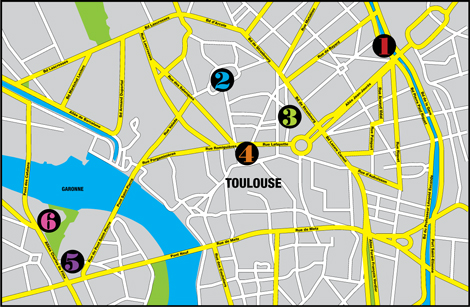From Romanesque churches to 20th-century shock-art, France’s pink city never fails to charm, finds Robin Gauldie.

MAISON DE LA VIOLETTE
The floating Maison de la Violette is a handy place to begin your stroll around Toulouse. If you’re burdened with bags, stash them at Toulouse-Matabiau station. It overlooks the Canal du Midi, which was created to link Toulouse with the Mediterranean in the 17th century.
Aboard a vintage barge moored on the canal’s west bank, founder Hélène Vié has created a museum and shop dedicated to the city’s iconic flower, the Toulouse violet, which gives the city’s football team its nickname – “les Violets”. Tradition has it that the flower was first brought to the city by Napoleon’s soldiers. Exhibits include postcards, posters and patchwork, but the main aim is to persuade you to sample, and perhaps buy, violet-perfumed sweets, liqueurs and teas. Open Mon-Sat 9.30am-12.30pm, 2pm-7pm; free entry. Canal du Midi at corner of Alleés Jean Jaurès, opposite Third Boulevard Bonrepos; lamaisondelaviolette.com
BASILIQUE ST-SERNIN
Walk down Allées Jean-Jaurès to Jean-Jaurès metro station, turn right, then at Jeanne d’Arc metro turn left. Ahead, the Romanesque campanile of Basilique St-Sernin is an unmissable landmark, and a dizzying example of what medieval builders could achieve using humble brick. The cathedral was built between 1070 and 1120 to house the relics of Toulouse’s first bishop, martyred in 250AD.
St-Sernin is still an essential stop for pilgrims on the trek from France to Santiago de Compostela, in northern Spain. Even for the less devout, it’s an impressive space, embellished by fine marble bas-reliefs and medieval frescoes – the latter were discovered when 19th-century plaster was removed from the walls. Look up to admire the red- and green-patterned brickwork of the cathedral’s spectacular vaulted ceiling. Open daily 10am-12pm, 2pm-5.30pm; free entry. 13 Place Saint-Sernin; basilique-st-sernin-toulouse.fr
MARCHE VICTOR HUGO
A five-minute stroll from St-Sernin, down Rue du Périgord and Rue du Sale, the Marché Victor Hugo is the gastronomic heart of a city that takes its food seriously. This huge modern emporium is crammed with stalls selling paté, seafood, cheese, charcuterie and, of course, meat. After all the fuss about horse meat finding its way into British burgers, the chevaline section is a reminder that the French eat it with gusto. More to British tastes are local specialities such as Toulouse sausage, cassoulet and confit de canard.
There are five restaurants on the first floor open for lunch only – try Le Louchebem (Tues-Sun 12.30pm-2.30pm; lelouchebem.com), where starters cost from €6 and meaty main courses are €13-€28. If you simply fancy a drink, join the locals at one of the market’s four stand-up café-bars. Open Tues-Sun dawn-1pm. Place Victor Hugo; marchevictorhugo.fr
PLACE DU CAPITOLE
A five-minute walk from the southwest corner of Place Victor Hugo brings you to the hub of the old city. There’s still a rosy glow to the pink brickwork that gives Toulouse its soubriquet and lends a special warmth to the arcades and café-terrasses around the Place du Capitole. Here, art deco bistro Le Bibent (at number 5) is the place to sample Toulouse’s signature cocktail, the purple kir royale à la violette, made with champagne and violet liqueur.
Dominating the square is the Capitole itself. It has been the seat of local administration on and off for centuries and, behind the eight pink columns of its grand façade, it still houses the municipal offices of the Hotel de Ville. In the Salle Henri Martin, ten huge canvases celebrate the city. In Les Rêveurs (the Dreamers), the central figure is socialist leader Jean Jaurès, who was assassinated for trying to head off the First World War. Opening hours vary – normally 9am-12pm and 2pm-5pm.
LE CENTRE DE L’AFFICHE
Take a two-stop ride on metro line A from Capitole to St-Cyprien-République, on the other side of the Garonne. St-Cyprien is Toulouse’s post-industrial area, where warehouses and factories are being reclaimed as housing and performance and art venues.
Check out the Centre de l’Affiche – dedicated to poster, postcard, packaging and label art, its huge collection offers a glimpse of how commercial graphic design and branding has evolved over some two centuries. Look out for Toulouse-Lautrec’s iconic poster promoting performer Aristide Bruant, in a broad-brimmed fedora and sweeping red scarf, in cabaret at Les Ambassadeurs. Open Mon-Fri 9am-12pm, 2pm-6pm; free entry. 58 Alleés Charles de Fitte; centreaffiche.toulouse.fr
MUSEE DES ABATTOIRS
A two-minute walk up Alleés Charles de Fitte from the Centre de l’Affiche, this collection of modern art is a challenge. Picasso’s immense La Dépouille du Minotaur en Costume d’Arlequin has pride of place, supported by some of the godfathers of 20th century shock-art. Mapplethorpe, Rauschenberg, Dubuffet and Duchamp are all represented in the collections of this former slaughterhouse. There’s an on-site café-bar, L’Hémicycle, where you can grab a stiff drink to help you recover from the sometimes startling impact of their work. Open Wed-Fri 10am-6pm, Sat-Sun 11am-7pm; entry €7. 76 Alleés Charles de Fitte; lesabattoirs.org








